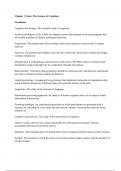Class notes
UWO Cognitive Psychology Textbook/Class Notes (PSYC2135)
- Course
- Psych 2135 (PSYCHOL2135)
- Institution
- University Of Western Ontario (UWO )
These documents will take you through the first six weeks of PSYC 2135. All of these notes are condensed versions of the textbook reading (Cognitive Psychology and its Implications, chapters 1-5) and class notes. At the beginning of each document, there is a vocabulary of important words in the tex...
[Show more]




